Rivian's second-gen R1 brings new utility, bold graphics and a richly designed interior
Californian EV maker Rivian has updated its flagship R1 SUV and pick-up, increasing their range, ability, and overall ambience with a blend of luxury and utility

Rivian has updated and enhanced its debut model, the might R1 EV. Founded way back in 2009, Rivian pivoted this way and that before eventually settling on a solid strategy as a maker of all-electric SUVs and pick-up trucks, two market sectors that were at that point soundly overlooked by the first generation of EV manufacturers.

Second Generation Rivian R1T and R1S
Those products, the R1S 7-seater SUV and R1T pick-up, were revealed in December 2017 and finally found their way to customers in late 2021. It was a tricky time to seed an innovative all-electric car range, with pandemic and conflict-driven supply shortages ramping up costs and delays. A side gig building out Amazon’s EDV (Electric Delivery Van) fleet has helped, as did the news of two smaller upcoming models, the Rivian R2 and R3.
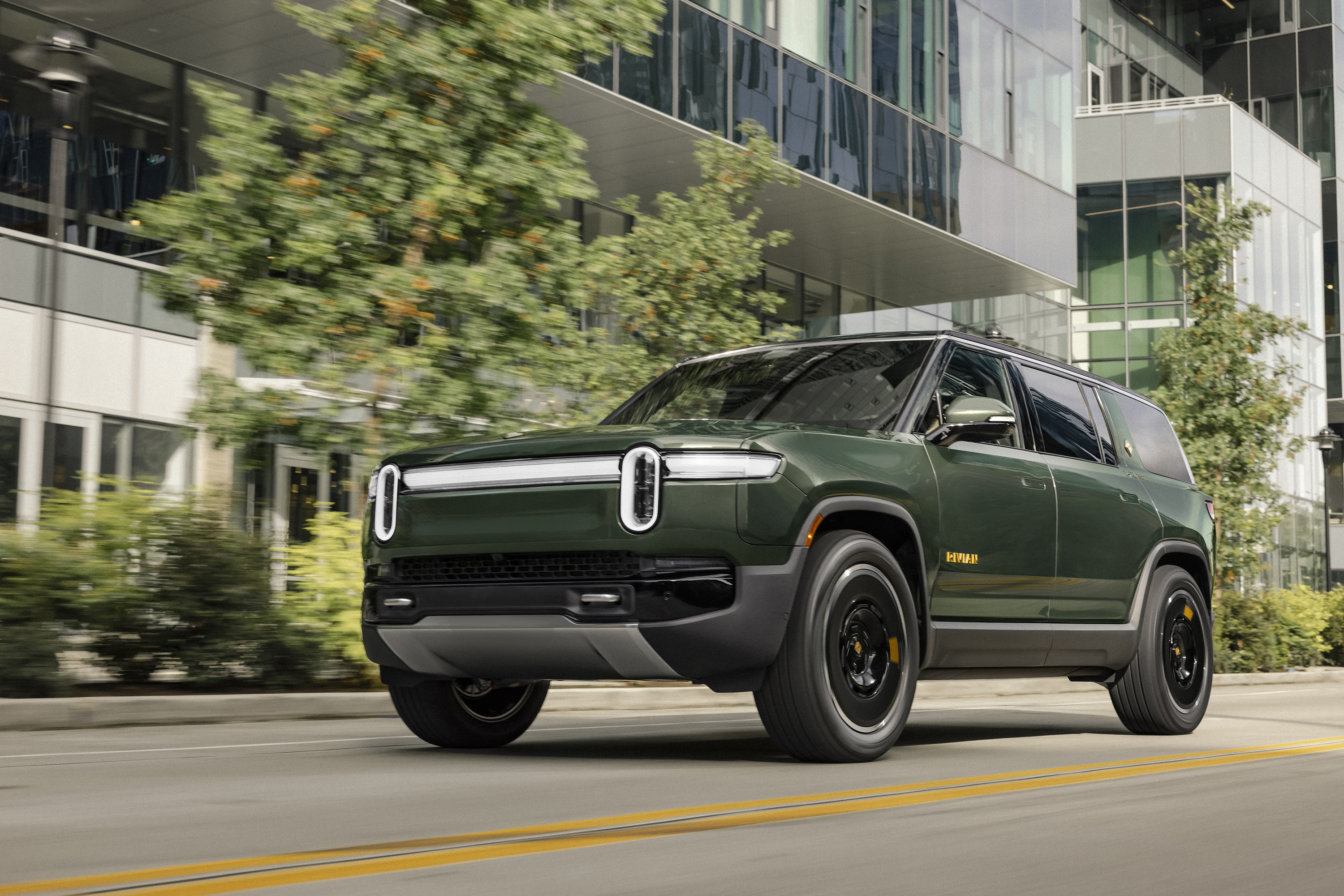
Second Generation Rivian R1S SUV
To bolster all this activity, the R1 is getting an update. Wallpaper* spoke to Rivian’s Chief Design Officer, Jeff Hammoud, about the changes and challenges of giving an instantly iconic vehicle a subtle but meaningful overhaul. ‘You have to let the customer see change and make it tangible,’ Hammoud acknowledges, but he cautions against the need for any overwhelming change. In the case of the R1 range, the existing building blocks are pretty solid.
On the exterior, the biggest changes are to the style and functionality of the lighting. Rivian’s signature vertical lozenge-like headlights now incorporate an Adaptive Drive Beam system, as well as new RGB LEDs in the horizontal light bar that add a new layer of functionality.

Second Generation Rivian R1T Pick-Up Truck
There’s a lot going on under the skin, with a substantial overhaul to the look and feel of the infotainment system, new materials and trim parts, and revisions and updates to the R1’s performance capabilities. ‘The look and feel of the software certainly influenced the hardware,’ Hammoud says, ‘especially elements like the headlights and light bar.’ New Gen2 architecture gives the car much more processing power, allowing the sensors to work harder and smarter on things like blind spot monitoring.
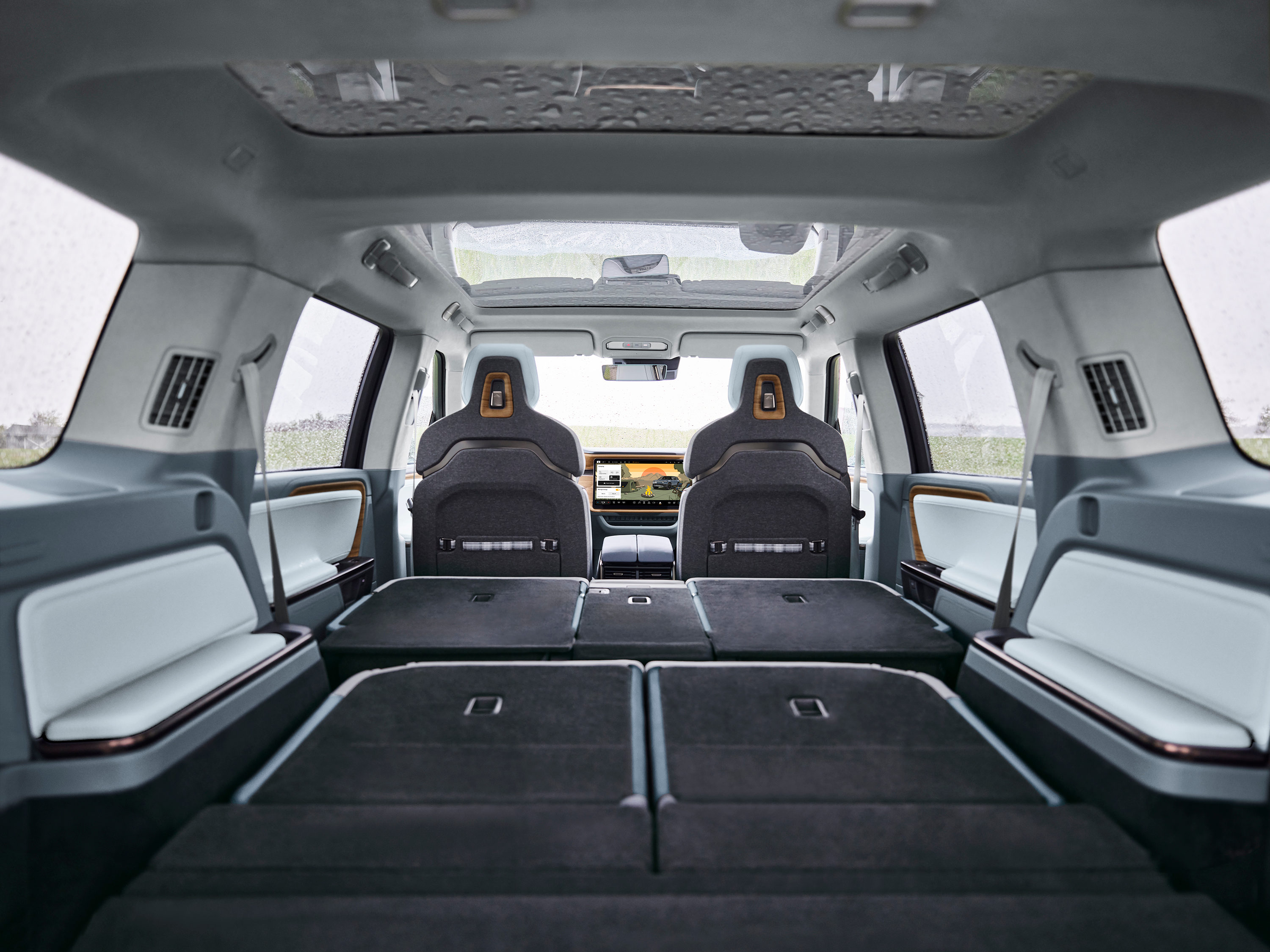
The R1 has a capacious interior
‘Our vehicle is software-defined,’ says Hammoud, ‘it’s really only us and Tesla who can make these big changes through software, so we really want to leverage that.’ Rivian spends a lot of time exploring what customers do and don’t like, including scouring message boards and groups on sites like Reddit to see what people are saying. ‘Every manufacturer is trying to push towards this, I think,’ he adds, ‘because you have smaller components, less wiring, OTA (over-the-air) updates – it’s very freeing as a designer.’
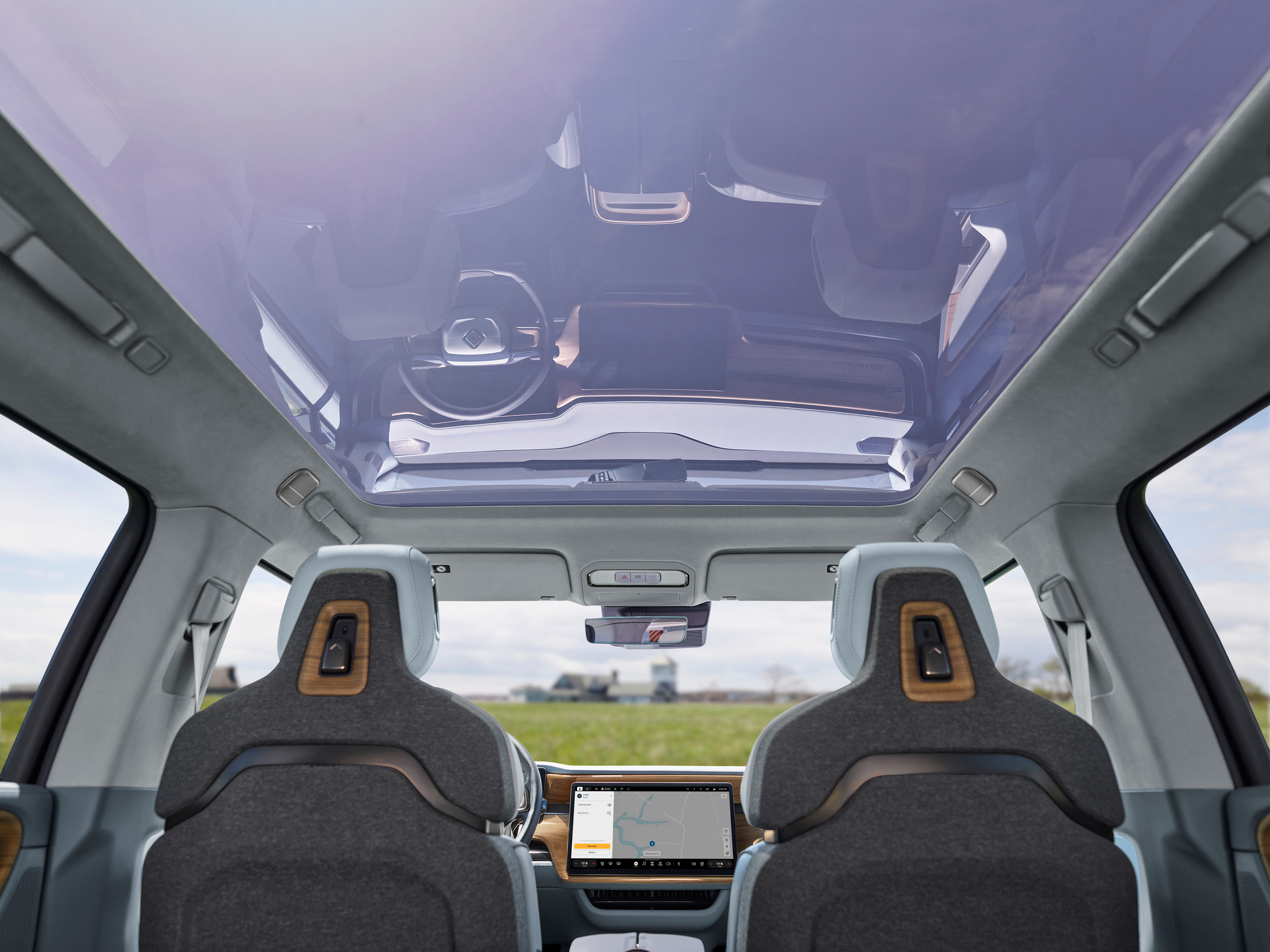
Inside Rivian's R1S
In either guise, R1 already has a reputation as a performer, both on road and off. Second generation cars will receive Rivian’s new drive unit in either Tri- or Quad-motor configurations, alongside the existing Dual-Motor option. No-one is especially wowed by the numbers that a big, heavy electric SUV can achieve any more, but for the record, the high-performance Quad-Motor has the equivalent of 1,025 horsepower and can shunt the R1T pick-up to 60mph in less than 2.5 seconds. Remember to secure any heavy loads.
Receive our daily digest of inspiration, escapism and design stories from around the world direct to your inbox.
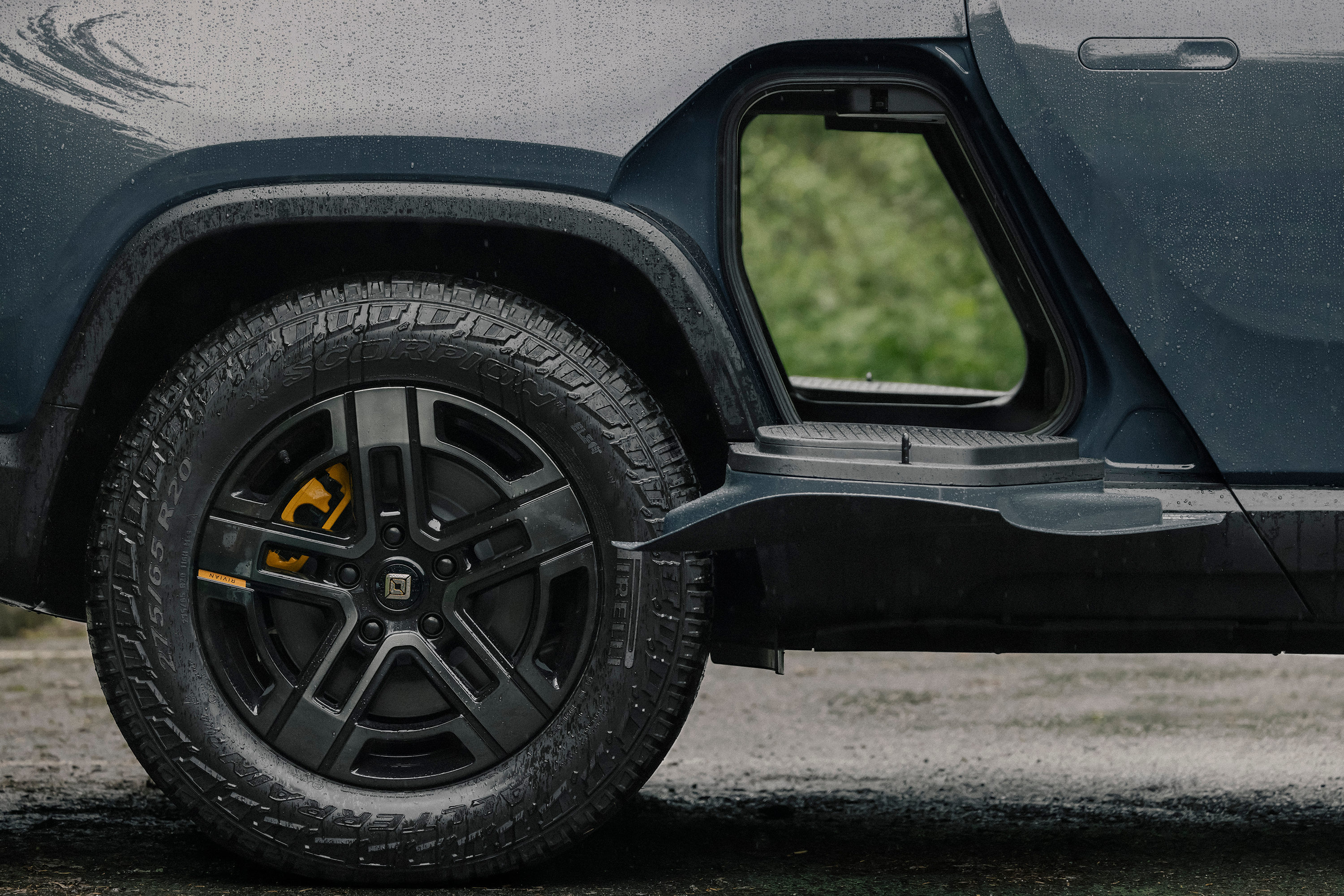
Utility extends to the unique through body storage areas
Big batteries and better energy management gives a projected 400+ mile range in the most abstemious drive mode on the most efficient model (real world experiences may vary substantially), with three different battery sizes on offer. At their core, these big Rivian trucks offer a huge amount of functionality for their target market, outdoorsy Californians who like to switch between highway and trail.
That core functionality and form is also why updates like this can be so successful. ‘You need to have the right hardware from the outset,’ Hammoud points out. ‘It takes four years to get a vehicle to market, but through software updates you can iterate things really quickly.’

Fold-down side panels allow for extra storage
One area where the design team has had a major impact is on the graphic style of the main screen. Change the drive mode and you’ll see beautifully stylised cel-shaded animations that signal the different options, from All-Purpose to the energy-efficient Conserve mode, as well as Sport and Snow. ‘We don’t like to take ourselves too seriously,’ says Hammoud, ‘and these show the car in a really unique way. It’s joyful utility.’
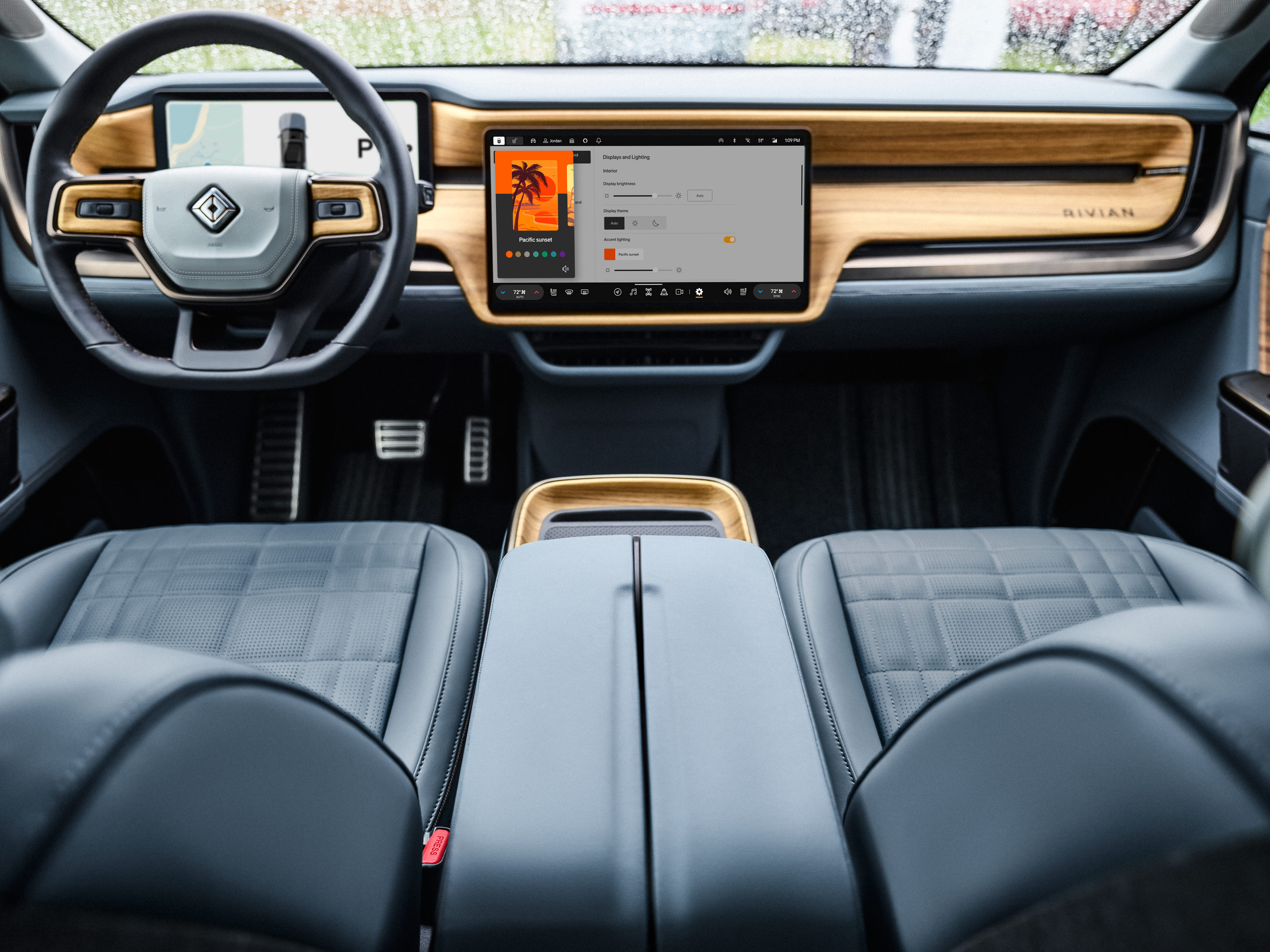
New wood trim options give the revised R1 a unique interior ambience
Other updates include optional Dolby Atmos with the Premium Audio specification, as well as keyless entry technology that can be added to your Apple Wallet or some Google Pixel phones. Other elements will come with time, including more and more autonomous driving features. These will utilize the 11 cameras and five radar systems and dedicated NVIDIA chips that have been baked in from the outset, but it’s not quite as simple as throwing a switch. Even so, Rivian is better placed than many to take advantage of what happens once social and legal barriers come down.
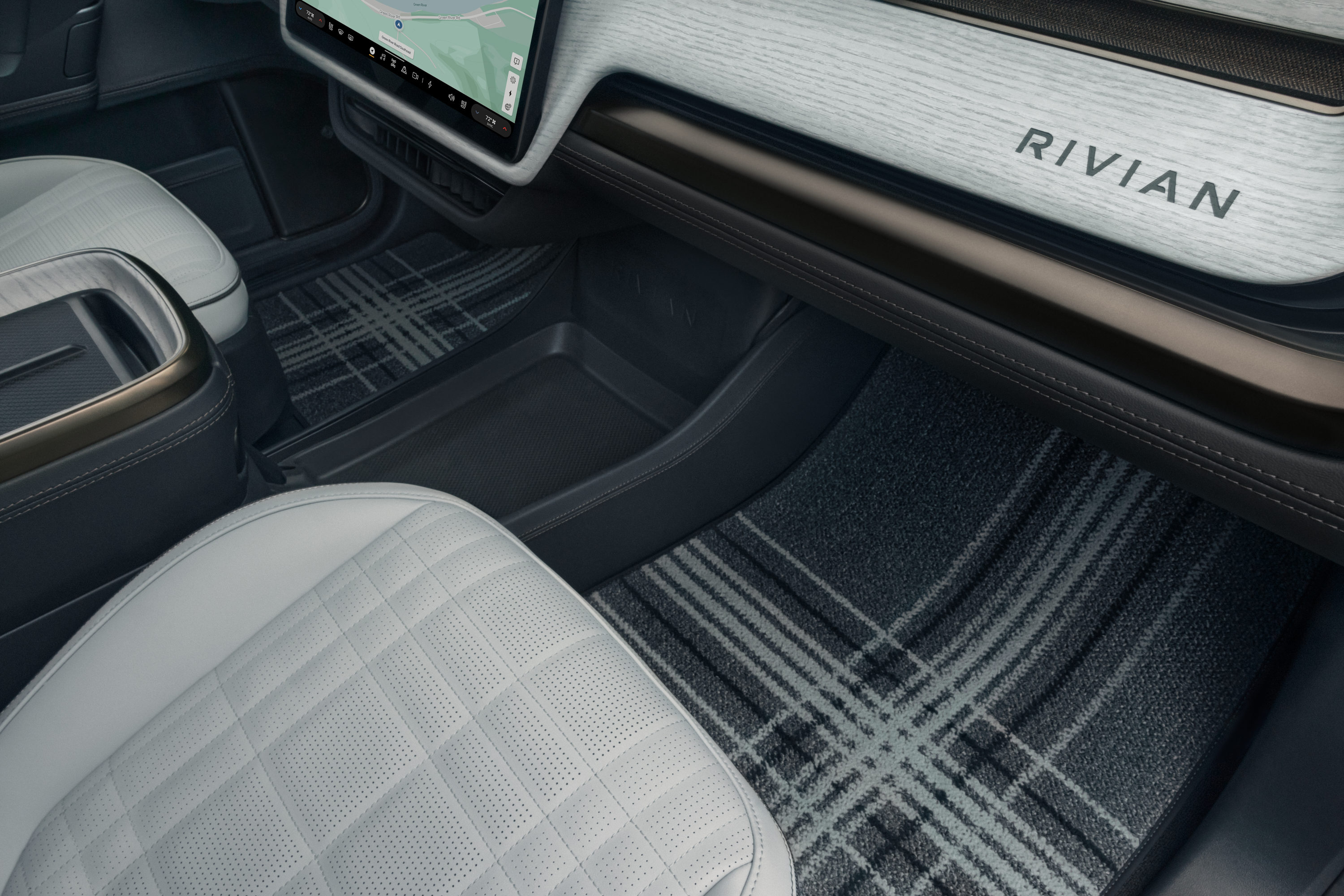
Other trim options include plaid upholstery
Under the skin, there’s enhanced and reengineered suspension (slightly smoother, as per customer feedback), and new wheels and tyres, whilst the revamped onboard computing set-up has allowed the company to simplify everything: 1.6 miles of wiring has been stripped out. ‘Our brand ethos is to be really intuitive,’ Hammoud says, ‘our customers also expect a certain amount of technology and well as engagement.’
Simplicity is still the watchword. Hammoud is especially proud of elements like the roof bars, which can be installed and removed by a single person with no tools. And while a pick-up truck will always signify a certain level of raw functionality, new interior trims and materials have elevated the experience substantially. These include exposed maple wood, brown stitching, accents of plaid textiles and ‘burnished bronze’ switchgear. ‘It’s like a sports coat with an elaborate liner,’ says Hammoud.
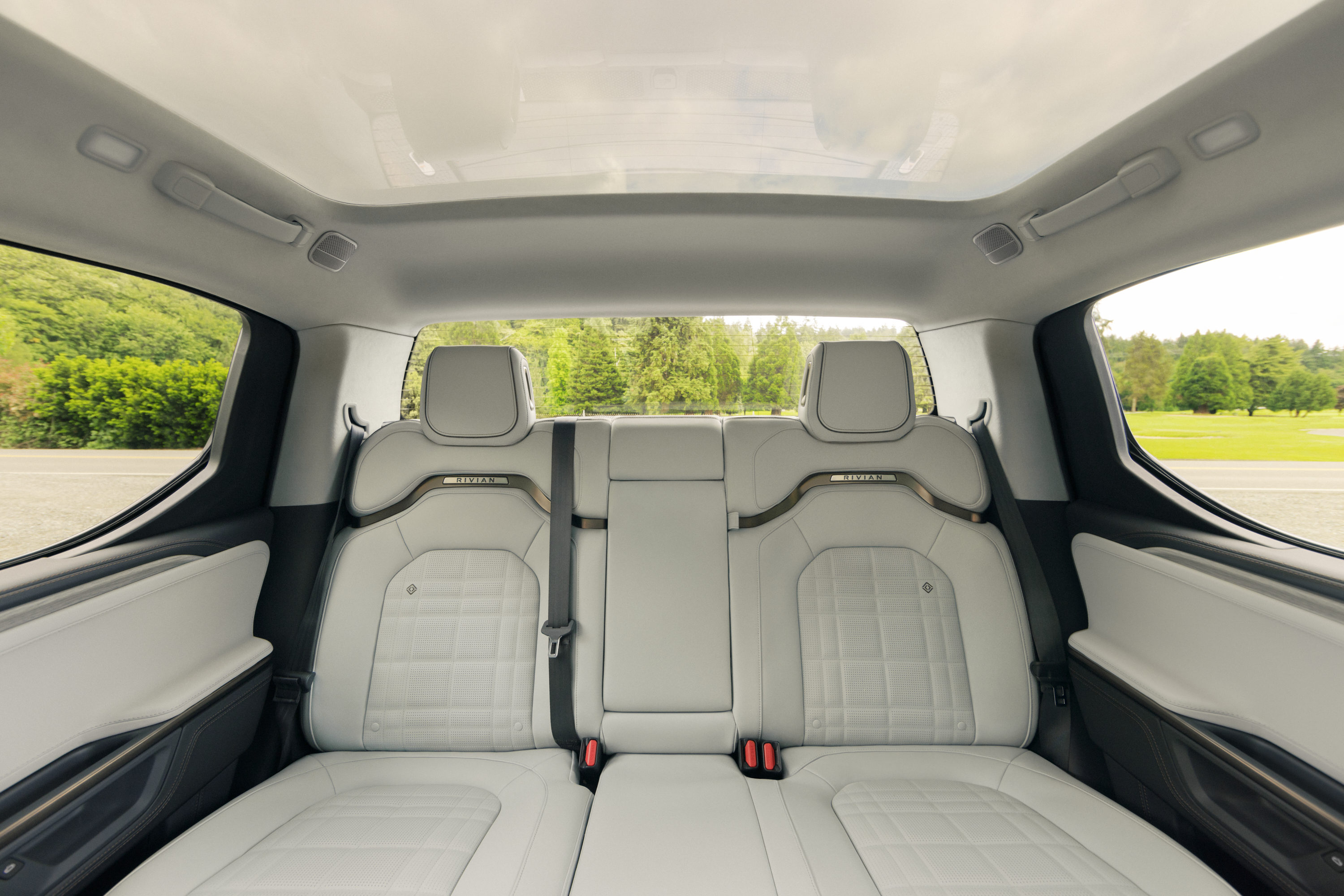
Inside the Rivian R1
Finally, there’s the opportunities created by the new lighting. ‘We spent a lot of time on the exterior lighting,’ the designer says, ‘and we can really change the user experience as a result. For example, you can see the state of charge on the horizontal light band, and we can do things like create emergency lighting systems to highlight hazards.’ This design-driven blend of innovation and experimentation continues to give Rivian an edge over its competitors and keeps the R1 high on our list of desirable EVs.

The Second Generation Rivian R1S
Rivian R1S Second Generation, from $75,900, Rivian R1T Second Generation, from $69,900, Rivian.com, @RivianOfficial
Jonathan Bell has written for Wallpaper* magazine since 1999, covering everything from architecture and transport design to books, tech and graphic design. He is now the magazine’s Transport and Technology Editor. Jonathan has written and edited 15 books, including Concept Car Design, 21st Century House, and The New Modern House. He is also the host of Wallpaper’s first podcast.
-
 Year in Review: we’re always after innovations that interest us – here are ten of 2025’s best
Year in Review: we’re always after innovations that interest us – here are ten of 2025’s bestWe present ten pieces of tech that broke the mould in some way, from fresh takes on guitar design, new uses for old equipment and the world’s most retro smartwatch
-
 Art and culture editor Hannah Silver's top ten interviews of 2025
Art and culture editor Hannah Silver's top ten interviews of 2025Glitching, coding and painting: 2025 has been a bumper year for art and culture. Here, Art and culture editor Hannah Silver selects her favourite moments
-
 In Norway, remoteness becomes the new luxury
In Norway, remoteness becomes the new luxuryAcross islands and fjords, a new wave of design-led hideaways is elevating remoteness into a refined, elemental form of luxury
-
 Rivian hits Miami Art Week to release R1S Quad Miami Edition, a new colour and a scent
Rivian hits Miami Art Week to release R1S Quad Miami Edition, a new colour and a scentVivid sights and evocative smells are part of Rivian’s quest to humanise its all-electric SUVs
-
 RBW EV brings a much-loved classic sports car aesthetic into the modern era
RBW EV brings a much-loved classic sports car aesthetic into the modern eraThe RBW Roadster and GT hark back to a golden age of sports car design. Under the skin, these British-built machines feature bespoke all-electric running gear
-
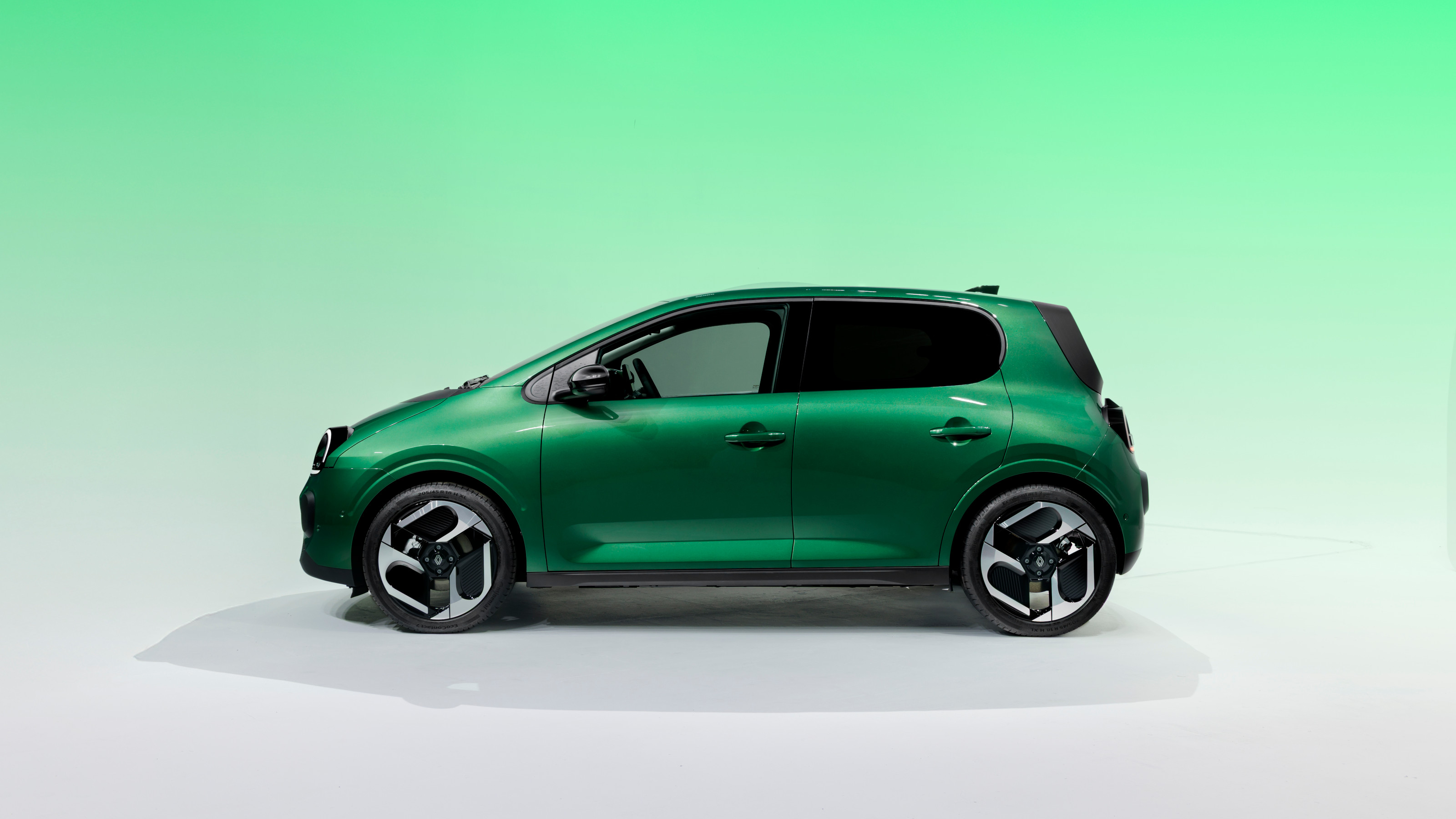 All hail the compact new Renault Twingo E-Tech – the city car is back in style
All hail the compact new Renault Twingo E-Tech – the city car is back in styleRenault continues to pay homage to its heritage by combining it with 21st-century technology. The new Twingo E-Tech is another winner
-
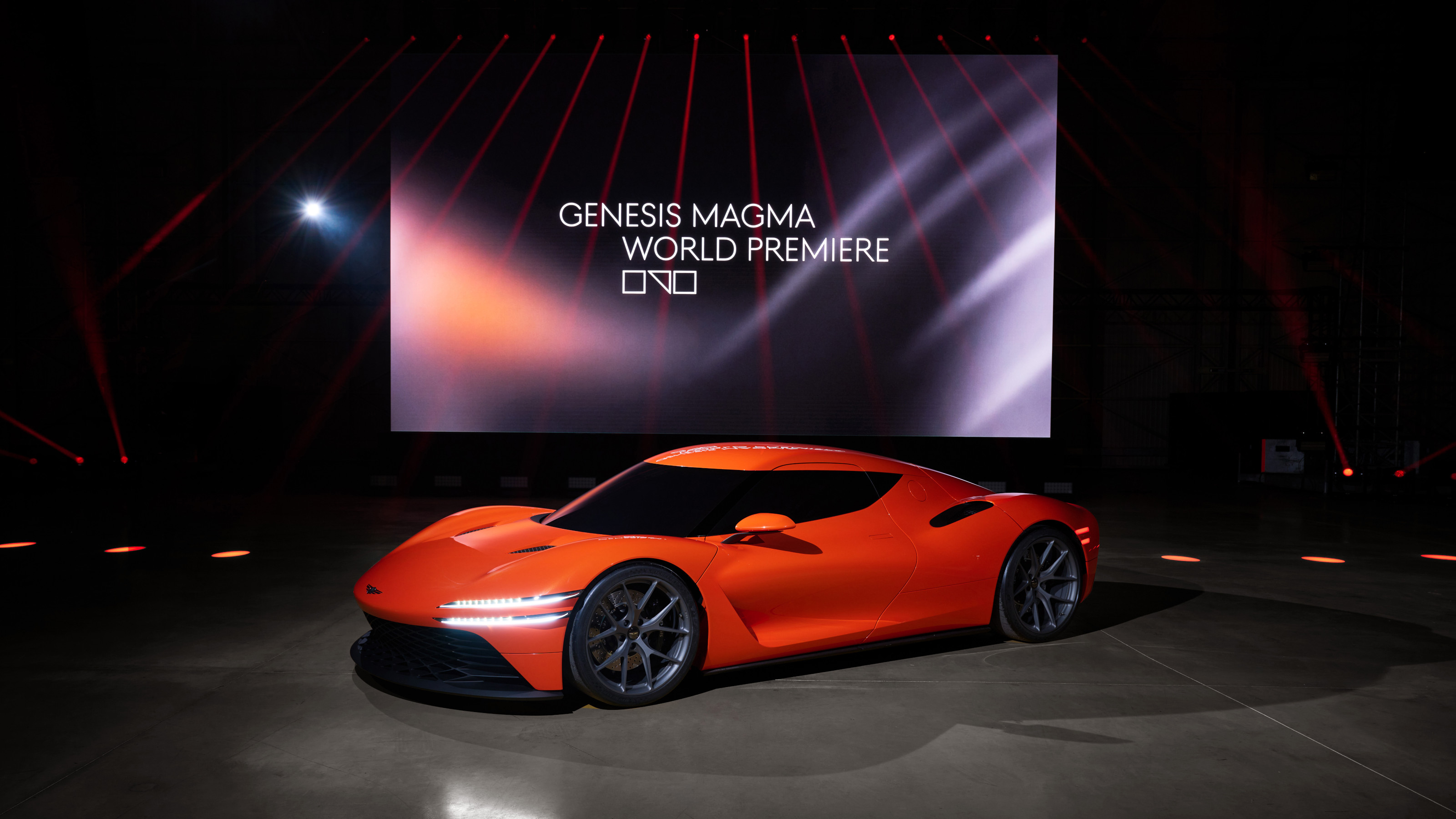 Genesis turns up the heat with its new Magma performance sub-brand
Genesis turns up the heat with its new Magma performance sub-brandGenesis has revealed the hot new GV60 Magma and striking Magma GT Concept in its quest to own luxury performance
-
 Around London in sybaritic silence with the majestic all-electric Lunaz Phantom V
Around London in sybaritic silence with the majestic all-electric Lunaz Phantom VClassic electrifier Lunaz has turned its skilled hands to the Rolls-Royce Phantom V. We sample the ultimate in zero-emission luxury on the streets of London
-
 Avatr Vision Xpectra concept transforms cars into ‘emotionally intelligent companions’
Avatr Vision Xpectra concept transforms cars into ‘emotionally intelligent companions’Revealed in Munich, electric car maker Avatr’s futuristic Vision Xpectra is a car that is not only beautiful, but a true form of ‘emotive luxury’
-
 Dacia wants to make small cars great again – all hail the new Hipster Concept
Dacia wants to make small cars great again – all hail the new Hipster ConceptThe best way to minimise energy use in all its forms is to downsize. The Dacia Hipster Concept is a smart way of making a practical car way more pint-sized
-
 The Vanderhall Brawley GTS is a compact but mighty electric off-roader
The Vanderhall Brawley GTS is a compact but mighty electric off-roaderDeliveries of Vanderhall’s Brawley GTS have started, bringing zero-emission trail driving to enthusiasts across America